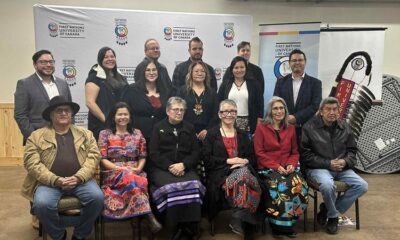Education
Indigenous Education in Crisis: Chiefs Must Reassess Their Role

Internal challenges are resurfacing at the First Nations University of Canada, drawing attention to persistent issues related to the intersection of governance and education within Indigenous communities. The Federation of Sovereign Indigenous Nations (FSIN) has faced criticism for allowing political leaders to retain control over educational institutions, a practice that some argue undermines effective administration and the pursuit of a progressive educational vision.
The roots of this situation extend back to the establishment of three educational institutions in the 1970s, which were intended to be governed by boards of directors composed of chiefs. The initial framework envisioned that chiefs would create policies while day-to-day management would be handled by professional staff. Fast forward to today, and it appears that the same chiefs continue to dominate the leadership of key educational bodies, including the Saskatchewan Indigenous Cultural Centre and the Saskatchewan Indigenous Institute of Technologies.
Historical Context and Current Dynamics
To understand the current governance challenges, one must consider the historical context of Indigenous leadership. When treaties were signed, the authority of chiefs was established, but subsequent government policies marginalized their roles, leaving them as figureheads while Indian agents exercised real power. Early Indigenous leaders, such as John B. Tootoosis and Walter Dieter, worked tirelessly to empower First Nations to elect their own leaders and reclaim authority that had been stripped away.
Despite these efforts, the role of chiefs has evolved into one that often mirrors that of the colonizers. Today, they are frequently tasked with administrative responsibilities that divert attention from their traditional leadership roles. An elder once remarked that as chiefs assumed more administrative duties, they risked becoming akin to Indian agents themselves. This shift places chiefs in a precarious position, where they are now perceived as obstacles to change rather than facilitators of progress.
As funding agreements are signed, chiefs bear the burden of responsibility for educational institutions without the requisite authority to enact meaningful change. The government retains control over funding, positioning Band councils as merely delivery agencies rather than empowered decision-makers. This power dynamic stifles innovation and hampers the drive for educational reform.
A Call for Change in Governance
The FSIN must confront the implications of neocolonialism within its own institutions. A significant step toward revitalizing Indigenous education would involve restructuring boards to include individuals with expertise in the educational field, rather than relying solely on chiefs.
In 2009, the federal and provincial governments mandated changes to the board structure of the First Nations University of Canada to ensure compliance with funding requirements. Despite this progress, a 2022 rule change by the FSIN allowed chiefs to return to the board without securing approval from funding agencies, raising concerns about the future of educational governance.
The past offers valuable lessons for current leadership. Historically, chiefs were vocal advocates for their communities, addressing the failures of government and standing firm in their commitment to their people. With the government now controlling vital resources, the level of advocacy has diminished, leading to a significant reduction in public protest and discourse.
Effective democracy relies on the inclusion of diverse perspectives from both elected and unelected members of the community. Traditional governance structures historically emphasized the importance of listening to elders, caregivers, and even children. Revisiting these principles could provide a pathway to a more effective and accountable educational system.
Indigenous communities stand at a crossroads. Embracing lessons from the past while re-evaluating the current governance model could pave the way for a more empowering and effective educational framework, ultimately benefiting future generations. As noted by Doug Cuthand, an Indigenous affairs columnist, the time has come for Indigenous leaders to reflect on their roles and recommit to the ideals of true leadership and community service.
-

 Politics4 weeks ago
Politics4 weeks agoSecwepemc First Nation Seeks Aboriginal Title Over Kamloops Area
-

 World5 months ago
World5 months agoScientists Unearth Ancient Antarctic Ice to Unlock Climate Secrets
-

 Entertainment5 months ago
Entertainment5 months agoTrump and McCormick to Announce $70 Billion Energy Investments
-

 Science5 months ago
Science5 months agoFour Astronauts Return to Earth After International Space Station Mission
-

 Lifestyle5 months ago
Lifestyle5 months agoTransLink Launches Food Truck Program to Boost Revenue in Vancouver
-

 Technology3 months ago
Technology3 months agoApple Notes Enhances Functionality with Markdown Support in macOS 26
-

 Lifestyle3 months ago
Lifestyle3 months agoManitoba’s Burger Champion Shines Again Amid Dining Innovations
-

 Top Stories2 months ago
Top Stories2 months agoUrgent Update: Fatal Crash on Highway 99 Claims Life of Pitt Meadows Man
-

 Politics4 months ago
Politics4 months agoUkrainian Tennis Star Elina Svitolina Faces Death Threats Online
-

 Sports5 months ago
Sports5 months agoSearch Underway for Missing Hunter Amid Hokkaido Bear Emergency
-

 Politics5 months ago
Politics5 months agoCarney Engages First Nations Leaders at Development Law Summit
-

 Technology5 months ago
Technology5 months agoFrosthaven Launches Early Access on July 31, 2025





















